11/05/11
Wadada Leo Smith: Ten Freedom Summers
Report on premiere of ambitious new work from trumpeter and composer at the RedCat Performance Center in Los Angeles, Calif.
Just as the ongoing cultural transformations which inspire trumpeter and composer Wadada Leo Smith continue to unfold, so did and does the creation of his great work, Ten Freedom Summers, which had its world premiere over three nights, October 28, 29, and 30, 2011, at the downtown Los Angeles RedCat multi-media performance space, operated by California Institute of the Arts, where Smith teaches. The performers of the work were comprised of Smith’s Golden Quartet, which included pianist Anthony Davis (from the original Golden Quartet created in the year 2000), bassist John Lindberg and drummer Susie Ibarra, and Southwest Chamber Music, led by conductor Jeff von der Schmidt. Visually complementing the music were films by Robert Fenz and Ismail Ali and videos by Jesse Gilbert and Carole Kim.
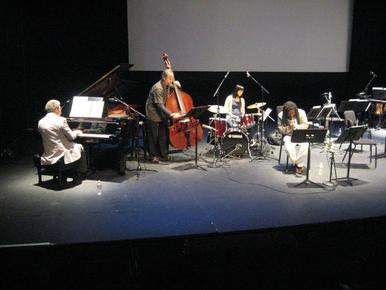
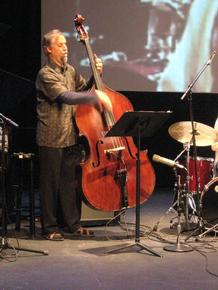
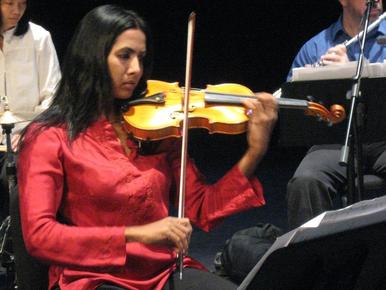
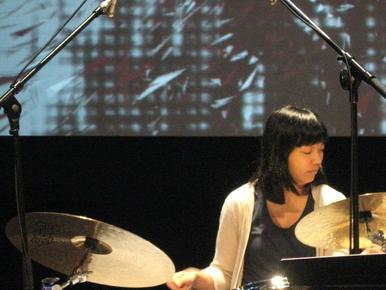
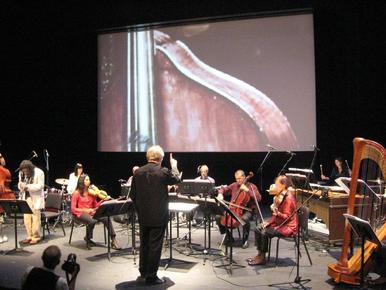
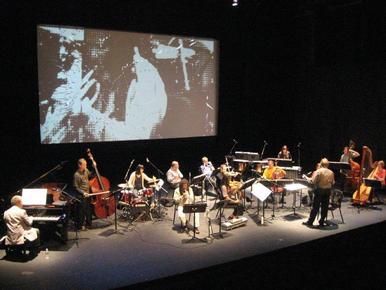
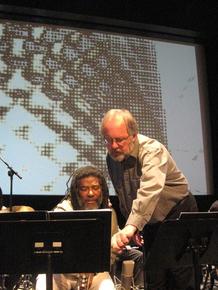
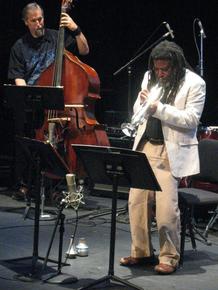
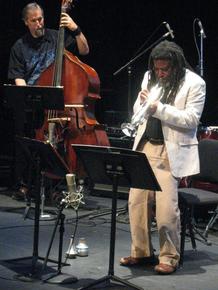
The Background
Ten Freedom Summers is structured in three collections, each of which has multiple pieces of music. Smith has written the pieces over a period of years, supported by a series of residencies, grants and commissions, the final one from Southwest Chamber Music. His idea to assemble them into one group was influenced by The Pittsburgh Cycle, a series of ten plays by the late African-American playwright, August Wilson.
The first collection of Ten Freedom Summers is called “Defining America;” the second, “What Is Democracy?” and the last, “Ten Freedom Summers.” Within each collection are pieces which not only musically describe significant individual characters active within and triggering the pursuit of civil rights in the decade between 1954 – 1964 (e.g. Rosa Parks, Medgar Evers, Emmett Till, Malcolm X, Fannie Lou Hamer and Martin Luther King), but also concepts pertinent to the formation of government and other entities evolving out of human interaction like the media and mega-corporations. Smith has said that the number of activists for civil rights is large, but he felt that his own message could be more powerfully conveyed given the people he chose for the context within which he was composing. Every person or event to which the music relates represented a seat for emotional response. The informational content of the music was an arrangement of notes, pictures and directives that covered numerous pages of score; metaphorically, the dynamics ran on the energy derived from Smith’s broad-based experience in the world.
Additional sources for Smith’s study of this era stemmed from documents and occurrences, external to the ‘54-‘64 decade, which concentrate on the conflicts and exigencies surrounding civil rights and striving for racial equality endemic to slavery, to how slaves became African-American citizens and to the place of women in society. The attention Smith gave to this subject matter allowed him to focus and, therefore, understand more thoroughly that which he has been concerned with all his life. Channeling his passions became a matter of translating them into the music he thought would best communicate what he felt in his heart.
Smith did not use his own Ankhrasmation method of writing Ten Freedom Summers. The score is traditionally notated; however, Smith’s interpretation of traditional notation is un-restricted. The notation can indicate more than is written, given Smith’s direction or suggestion of how the music needs to sound.
His combining of the forces of Golden Quartet and Southwest Chamber Music averted plugging into a paradigm of “Third Stream” so often associated with the music of Charles Mingus as Gunther Schuller describes it. Rather Smith intended to find the most complete tonality to enrich the communication of his musical visions. It is a false assumption that Smith has combined “jazz” and “classical” music to maintain the integrity of each, even as the instruments of both genres are played on the same stage. Golden Quartet played music that has roots in blues and jazz because Smith was born into the idioms. He is from the deep Mississippi south. Yet, for his multi-part piece, he developed a sound based on a wide spectrum of instrumental colors, coming from violin, viola, cello, harp, tympani, marimba, gongs, miscellaneous percussion, concert bass, glockenspiel, bass clarinet, and flute, all of which are commonly utilized in jazz groups and not exclusive to classical chamber ensembles, such as Southwest Chamber music.
The Music
Well publicized and highly anticipated for weeks ahead of time, Ten Freedom Summers radiated nothing but the seriousness of Smith’s message over the duration of its performance. The piece is designed so that the Quartet plays some sections exclusively, Southwest Chamber Music plays other parts exclusively and some sections are played by both groups. There are varying combinations of players of both groups which play together also; the most prevalent bond was pianist Davis with members of Southwest Chamber Music ensemble.
From the audience’s view of the stage, Golden Quartet was situated on the left and the nine players of Southwest Chamber Music were on the right. The conductor stood just right of center. In fact, no one occupied the center of the stage. The center was an empty space: Smith was on the left of that space and first violinist Shalini Vijayan was to the right. The far left was occupied by the piano and the far right, by the harp, those two instruments acting as parenthetical boundaries for the sound-making collective.
No dearth of drama, paucity of fiery expression or lack of poly-rhythms escaped the evolution of the numerous musical stories Smith had composed. It must be emphasized that although Smith had written thousands of notations instructing all the players how to shape their parts, he was determined to establish an essential resonance, an essential expression: made of clipped, repeated and elongated phrasing; rounded, bittersweet or jagged tunefulness; fluid, synchronous and syncopated melodies; and charged or tender expositions of the moments. Even if that meant that the Chamber Music players needed to stop counting, von der Schmidt needed to stop conducting and they needed to let themselves reach their destination without following what was written on the page.
The music was studded with the metallic brilliance of the horn and a piercing continuously bowed high-note on the violin. Grace and reverence exuded from a sole quartet of the strings. As did the same come from the extraordinarily limber arm motion which forecast the character of Ibarra’s drumming range – from marches on the snare drum to touches of a vertically-held drumstick on the edge of a cymbal to a rumbling of the toms in the company of the bass drum tones. The low and large booming of the tympani and concert bass drum served to share in delivering the hugeness of the sound of the collective to a point that Smith desired to be the loudest in the whole work.
At times inserting one of two mutes into his horn, Smith sculpted his improvisations as though he were playing for the first and last time. As he played with his horn pointing to the stage floor, his body bowing from the middle, his black dreads both dangling around his cheeks and laying on the shoulders of his white jacket, he evoked sorrow and melancholy; as he belted out voluminous phrases, his knees partially bent when in an upright position, in order to propel the sound through the bell of the horn from his inner being out to the audience, he described terror and cries of oppression, darkness and suffering. With his right hand raised in the air and the trumpet still held to his lips with his left hand, Smith guided the players often into silence; those silences were the place for breath and contemplation to transition to the next places.
Sometimes the pace at which the instruments played was outrageously endless and strong. The pounding of the drums and the bowing of the basses blended with the beating of many hearts, thousands of hearts, a population’s worth of hearts. As Smith intended.
When Golden Quartet latched onto a captivating blues vibe, there was no going back. No less powerful than all the instruments of the orchestra combined were Lindberg’s bass pizzicatos and Davis’ stunning arpeggios. Lindberg and Smith are tied at the hip; Lindberg is inclined to speak Smith’s musical language without stuttering. Davis hung low over the keyboard and played not so many bass chords as distinctive treble trills. Speaking with her own technique, drummer Ibarra converted easily to the Smith sense of timing and attack.
Symptomatic of Smith’s process is that the players who work with him “unlearn” how they normally play and coincide with the properties of the music he has created. Remarkably, this whole ensemble, quartet and chamber music group alike, complied with Smith’s underlying intentions simply by listening to him, as he spoke as composer in rehearsals, and as he played as musician and trumpeter in performance. His trumpet is silver and his spirit shines golden. And no matter how many questions were asked of him, the answers he gave to those questions, both verbally and musically were genuine, thoughtful, mindful and creative.
The films and video visualizations projected behind the orchestra during parts of the performance did not distract from the music; they elucidated the subject matter beautifully and physically embraced the theater space. They added yet more color to the already colorful journey that Ten Freedom Summers provided. Sometimes lines and shapes moved across the screen as the sound changed; at other times, integrated into the graphics appeared images of the players as they played their instruments. At the beginning of the second collection, a short black and white silent film showed Smith playing his horn in the sunlight within a foreshortened space. Introducing the third collection, a second silent film, in color, revealed a series of overlays, intersecting in the middle of the screen, abstractly picturing the fence along the US/Mexico border.
Ten Freedom Summers was recorded on November 4, 2011 in studios at the Coburn School for Performing Arts, across the street from the RedCat Theater. The recording will be released on Cuneiform Records in May, 2012.
The Upshot
No matter how one approaches and absorbs Ten Freedom Summers, as musician, artist, historian, sociologist, activist, or born of a particular ethnicity, the crux of this music, albeit of epic proportions, is simple. Eloquently explained by Smith, true freedom is not found or discovered because of fortune; it is earned through the persistent quality of the hard work of those who struggle to make themselves heard. More than once, he has said that we, in America, are free because of “the advantage that race has given us.” And it is not particularly who or what group of people was behind the surge of speaking so loudly that their words were heard over vast distances and for eternal spans of time. Or who was killed tragically and senselessly in the shadows of hypocrisy. Or who was silenced, interrupted or jailed to halt their mere efforts to speak publicly. Most importantly, it is the principle within their actions and words that requires deep understanding and respect. Only then, will the responsibilities that are freedom’s marrow be accepted and implemented. Only then, will the divides be lifted. Only then, will the human population possess equanimity and the capacity to share compassion. And only then, will the fear of living dissolve and the inevitability of death become acceptable.
The basis for the construction of Wadada Leo Smith’s Ten Freedom Summers emanated from artistic collaboration and cooperation among a variety of musicians, visual artists and sound engineers, each educated in a different discipline and originating from a different background. Taking away that observation, alone, from the performance was worth the price of admission… the music, of course, forever memorable.
CREDITS
The Players
Golden Quartet: Anthony Davis, piano; Susie Ibarra, drums; John Lindberg, bass; Wadada Leo Smith, trumpet.
Southwest Chamber Music: Alison Bjorkedal, harp; Jim Foschia, clarinet; Lorenz Gamma, violin; Peter Jacobson, cello; Larry Kaplan, flute; Jan Karlin, viola; Tom Peters, bass; Lynn Vartan, percussion; Shalini Vijayan, violin; Jeff von der Schmidt, conductor.
Ten Freedom Summers
First Collection: Defining Moments in America
Optics [Ismail Ali]
Dred Scott: 1857 [Golden Quartet];
Malik Al Shabazz and The People of the Shahada [Golden Quartet];
Emmett Till: Defiant, Fearless [Golden Quartet and Southwest Chamber Music];
Black Church [Southwest Chamber Ensemble];
Freedom Summer: Voter Registration, Acts of Compassion and Empowerment, 1964 [Golden Quartet];
The D. C. Wall: A War Memorial for All Times [Golden Quartet];
John F. Kennedy’s New Frontier and the Space Age, 1960 [Southwest Chamber Music].
Second Collection: What is Democracy
Butterfly: Silver [a film by Robert Fenz]
Rosa Parks and the Montgomery Bus Boycott, 381 Days [Golden Quartet];
In the Diaspora, Earthquakes and Sunrise Missions – 1 [Southwest Chamber Music];
Fannie Lou Hamer and The Mississippi Freedom Democratic Party, 1964 [Golden Quartet];
Medgar Evers: A Love-Voice of a Thousand Years Journey for Liberty and Justice [Southwest Chamber Music];
September Eleventh 2001: A Memorial [Golden Quartet];
Buzzsaw: The Myth of a Free Press [Golden Quartet];
Lyndon B. Johnson’s Great Society and the Civil Rights Act of 1964 [Southwest Chamber Music, Shalini Vijayan & Wadada Leo Smith]
Third Collection: Ten Freedom Summers
Crossing [a film by Robert Fenz]
In the Diaspora, Earthquakes and Sunrise Missions – 2 [Southwest Chamber Music];
Thurgood Marshall and Brown vs. Board of Education: A Dream of Equal Education, 1954 [Golden Quartet];
The Freedom Riders Ride [Golden Quartet];
The Little Rock Nine: A Force of Desegregation In Education, 1957 [Golden Quartet & Southwest Chamber Music];
America Parts 1 & 2 [Golden Quartet];
Democracy [Golden Quartet];
Martin Luther King, Jr.: Memphis, The Prophecy [Southwest Chamber Music & Golden Quartet].

 E-mail
E-mail Share
Share RSS
RSS
Add a Comment
You need to log in to comment on this article. No account? No problem!